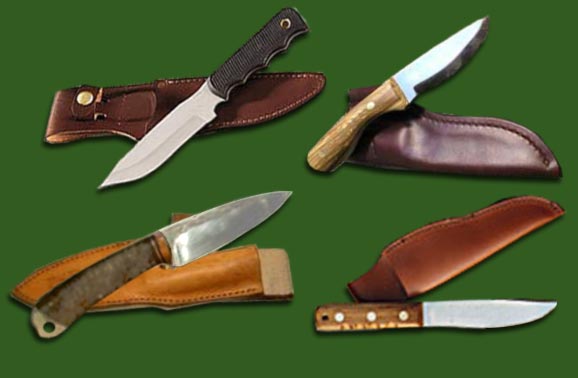
All Text, Graphics, Animations, Video, and Commentary on this website was created by, and is the intellectual property of m4040@m4040.com. All Rights Reserved. Unauthorized reproduction is punishable by up to a $500,000 fine or 5 years imprisonment for a first offense, and up to a $1,000,000 fine or up to 10 years imprisonment for subsequent offenses under the Digital Millenium Copyright Act (DMCA). Requests for use of this material should be forwarded to m4040@m4040.com.
FIELD BLADE REVIEWS
M40 SURVIVAL KITS ON SALE NOW!
“Bush” Blades... Function or Fad?
- By M40 – Sept, 2007

I know the term "bush knife" has come to signify a blade about 4-6" in length and about an inch to 2" wide. Many have stag or hardwood handles, and some even sport really beautiful craftsmanship. I'm not sure just how and why these came into fashion or how folks came to think that these had any place in an outdoors environment. The design falls FAR short of what an outdoors blade should be. I've seen pocket knives that sport bigger and more functional blades.
These are skinners maybe, but definitely not choppers (the primary task of an outdoors blade). Oddly enough, there's very little whittling to be done in most wilderness survival situations. If the size and weight of these "bush" knives appeals to you, you really should consider packing a decent folder or a multi-tool instead. A multi-tool has a lot more to offer in the way of tools you can actually use.
Survival shows abound these days, and they have a definite "green" trend going. The hosts carry these small "bush" knives and "tracker" blades because the shows are trying to be politically correct, not because these are the ideal tools. Those big, mean looking blades must frighten the pink-panty wearing crowd among us.
You can learn a lot from history. Look at almost any point in history since the advent of steel, and examine what was carried by those who lived close to nature. The closer they were to the environment, the bigger the blades they carried. Ma Nature provides big, sharp fangs and claws and quite a bit of brute force to her pets, so make sure your "fang" is the sharpest, biggest brute you can comfortably wear and wield.
A true bush blade (as I would make it) is a chopping machine. It's a large bowie or kukri style blade with a weight-forward balance that makes short work of brush and limbs. It's a one-tool carpentry shop that can whip up a shelter on short notice when the weather rolls in. It has the brute chopping power of a hatchet or machete, but the wearability of a hunting knife. Finally, it's got enough length to be shave sharp at the hilt and point, but a belly that is sharpened to a durable chopping edge.
Ideal wilderness blades (and I've examined the blades carried by many a wilderness survival instructor), are long, thick, carbon steel powerhouses that take a scary-sharp edge and then hold it through a mile of trailblazing. They're the kind of blades you can apply your full weight to, and not worry about snapping them. Also, they aren't so costly that you baby them to keep from marring them. They are tools designed to perform brutally hard work... chopping, digging, prying and hammering. In short, don't haul anything into the woods that you don't mind marring the crap out of. Those $500 blades may be pretty, but if you're afraid to actually use them, just leave 'em at home!
I'm not trying to be a jerk or anything, and I'm not criticizing those who've bought "bush" blades. I've been there... in the woods... in a survival setting... with a "survival" knife that turned out to be "not enough blade". At that moment, I sure wished I had a chopper instead. I just want to see folks pack the right gear for the job, and the job is chopping.
I've not only had to live off the land with a blade, but I've spent years practicing the skills needed to do so. I'm now a "basement bladesmith" and have forged and/or stock-removed my share of outdoor blades. I've tested each to see what makes it good and what makes it bad. There's a lot of factors there, but one thing has always held true: A big blade can do anything a little blade can, but the reverse is DEFINITELY not the case.
To sum up, I'd rather see someone tackle the outdoors with a $15 Ontario mil-spec machete than any of those really expensive and pretty "bush" blades.
Return to M40's Kukri Modification Page